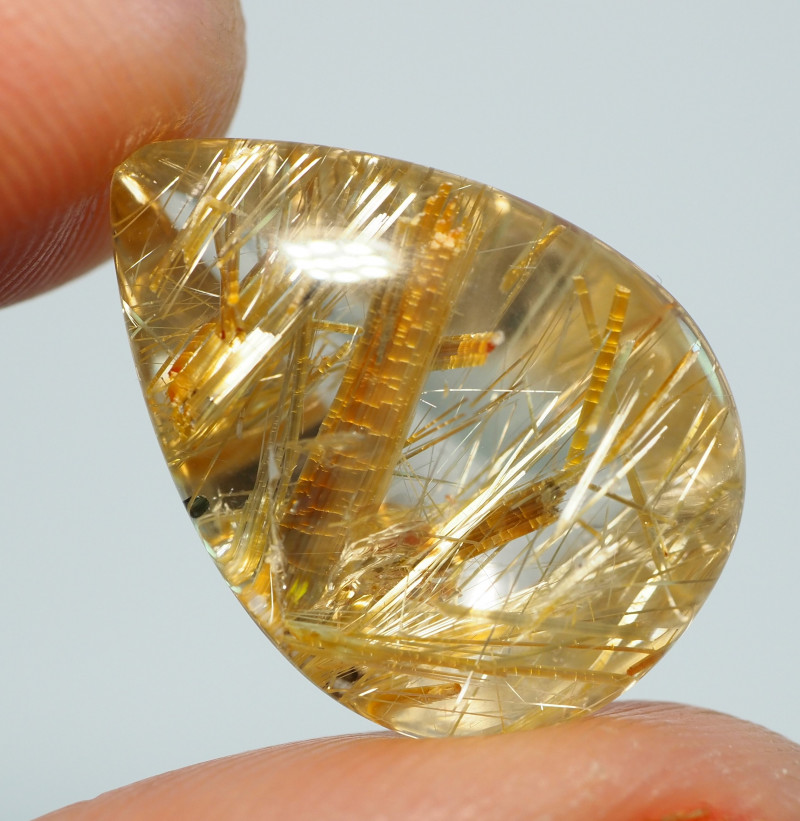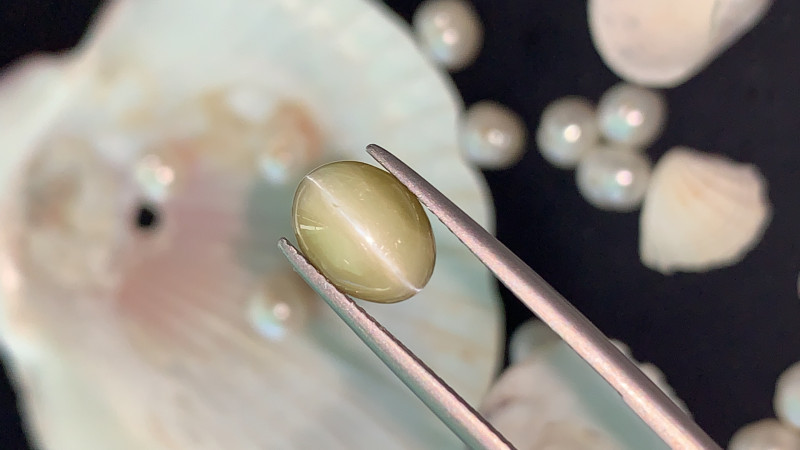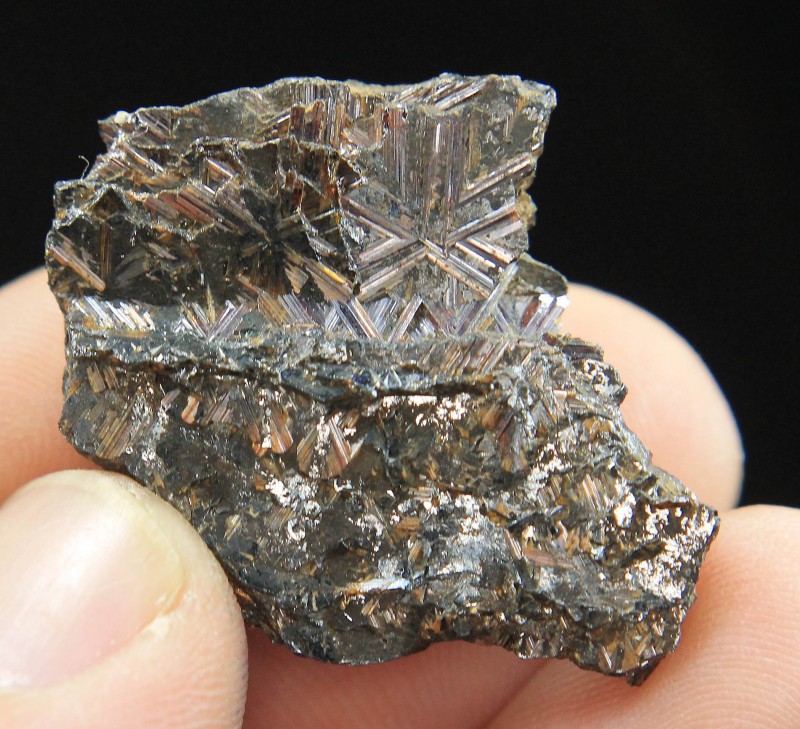
金红石宝石:特性、含义、价值等
 金红石是一种常见的金色或红色矿物,因其是金红石石英等其他宝石的内含物而闻名,并且具有所有晶体中最高的折射率值之一。
金红石是一种常见的金色或红色矿物,因其是金红石石英等其他宝石的内含物而闻名,并且具有所有晶体中最高的折射率值之一。
金红石是稀有矿物吗?一点也不。事实上,金红石是自然形成的最常见的二氧化钛类型。即便如此,可刻面尺寸的宝石级金红石晶体却并不常见。
如果您曾经听说过一种名为“金红石石英”的石英,其中有金色的针状物,或者有一种“猫眼”的宝石,那么您可能在不知不觉中就见过金红石。
但什么是金红石宝石?金红石本身又是什么?我们将深入探索金红石和金红石宝石的世界,解答您的所有疑问,甚至更多。
 图片来源:Ra'ike | Creative Commons Attribution-Share Alike 3.0 Unported 许可证
图片来源:Ra'ike | Creative Commons Attribution-Share Alike 3.0 Unported 许可证
什么是金红石晶体?
金红石,历史上又称“红金红石”,通常出现在珠宝界的其他宝石之中。单颗晶体被视为收藏品。不过,金红石也被用作双子座和金牛座的星座石。
它除了是最常见的天然二氧化钛之外,还常常含有两种稀有金属:铌和钽。
鉴于其珍贵的成分,金红石的用途是什么?
工业金红石用途
金红石的主要工业用途是制造或提取:
白色颜料——用于油漆、纸张、塑料等
防晒霜——纳米粒子吸收紫外线
钛金属——矿物中钛含量为 30%
偏振光学——由于高折射率
耐火陶瓷——用于冶金窑炉、坩埚等
焊接电极覆盖层——保护金属免受大气影响并稳定电弧
除了其成分之外,金红石还具有优异的耐热、耐压和耐化学性,可用于折射陶瓷等应用。它在偏振光学中的应用源于其极高的折射率、 色散和双折射。
进一步说明金红石的重要性:金红石是二氧化钛中最好、最纯净的天然形式(由 30% 的钛组成),二氧化钛用于世界上大约三分之二的颜料!
话虽如此,金红石标本几乎总是被其他元素弄得不纯,这就给我们带来了金红石的矿物特性。
金红石规格和特性
金红石是一种二氧化钛矿物,化学式为TiO2。金红石是四方晶系氧化物金红石族中最常见的一种,该族还包括锡石。
这种矿物是二氧化钛的三种天然形态之一,另两种是锐钛矿和板钛矿。这三种形态均为多晶型(化学成分相同,但晶体结构不同),但金红石和锐钛矿是主要形态。
锐钛矿和金红石都用于白色颜料,但两者的颜色和吸光度不同,因此只有金红石用于防晒霜。此外,在金红石、锐钛矿和板钛矿中,金红石最常用于宝石。
当金红石不形成针状晶体包裹体时,其晶体通常呈棱柱状,并带有垂直条纹。多个晶体(最多 8 个)可以形成接触孪生,偶尔会形成晶体环。您还可以找到块状或颗粒状的金红石。
以下是其余金红石的性质:
莫氏硬度:6-6.5
颜色:金色、红色、红棕色、棕色、棕黄色、绿色、黄色、淡蓝色、紫色、黑色、灰色、灰黑色
晶体结构:四方
光泽:金属光泽、亚金属光泽或金刚光泽
透明度:透明至不透明
折射率:2.62-2.90(超限)
密度:4.20-4.30(含铁4.20-4.40,含钽4.20-5.60)
解理:[110] 处良好/明显,[100] 处中等;[092] 和 [011] 处分离
断口:贝壳状、亚贝壳状或不规则状
条痕:灰黑色、浅棕色或浅黄色
发光:无
多色性:存在,弱到强的棕色、红色、黄色和绿色二色性
光学效果:有时有猫眼效应
双折射率:0.287
分散性:0.28-0.33(极强)
接下来,我们将从单个属性转向其众多的金红石品种和金红石宝石。
 上图:Sagenite 金红石
上图:Sagenite 金红石
金红石的种类
我们先从金红石的种类说起。钽、铌和铁是金红石中常见的杂质。铁可能会取代部分钛,而金红石的铁含量可能高达10%。这引出了金红石的变体:
钛金红石/铌金红石:黑色,含铌变体
Strüverite :黑色、含钽变体,有时含有铁和/或铌(铌含量必须低于钽含量)
钛铁矿:富铁变体或金红石和钛铁矿的组合
Sagenite :具有双晶网格状网络的变体
“Sagenite” 也用于指金红石玛瑙(有时称为金红石玛瑙)以及其他含有针状金红石或电气石内含物的石英或玉髓石。
金红石宝石的种类
在其他宝石中, 金红石内含物通常呈针状晶体或微观纤维状。这些内含物可能指向多个方向,或形成致密的束状,从而产生光学现象。
哪些宝石可以制成金红石?我们将在下面列出,从最著名的开始。
金红石英

最受欢迎的金红石或许是金红石石英,又称金红石石英。通常,这种石英晶莹剔透,内部布满金色的金红石针状结构。每颗金红石针状结构的形状、颜色和大小各不相同,因此又可分为以下几个品种:
维纳斯发石:含金色金红石内含物的品种
星光金红石石英:具有六组包裹体,从中心点向外延伸,形成星形的品种
涂鸦石英:透明石英,带有黑色金红石针
虽然金红石石英是粗晶质的,但金红石也可以出现在玛瑙等微晶质(玉髓)品种中。
刚玉(蓝宝石和红宝石)
 上图:星光蓝宝石
上图:星光蓝宝石
蓝宝石或红宝石等珍贵宝石中的内含物通常会降低宝石的价值。然而,密集平行的金红石纤维束(称为“丝”)可以在宝石表面反射出4或6射线的“星光”,这被称为星光,从而提升宝石的价值。
你见过卖“星光红宝石”或“星光蓝宝石”吗?那些是金红石!虽然很多黑色星光蓝宝石里含有赤铁矿内含物,但有些产自泰国的蓝宝石里却有由金红石和赤铁矿针状物组成的12道星光。
然而,如果金红石不会产生光学效应,珠宝商可能会对红宝石进行热处理以溶解金红石并提高清晰度。
那么,“猫眼”效果怎么样?
猫眼石
 上图:猫眼石(金绿玉)
上图:猫眼石(金绿玉)
如果金红石表面反射的光线只有一束,而不是多束,这就称为猫眼效应或“猫眼”效果。
最明显的例子是猫眼石金绿玉,简称“猫眼”。其他猫眼石必须在其后加上自己的名字(例如猫眼硅线石)。
其他猫眼金红石包括:
猫眼效应也可能由宝石本身的纤维状或层状结构所致,例如虎眼石。即使是单颗金红石也可能具有猫眼效应!
其他含金红石的宝石
 上图:含有金红石内含物的碧玺宝石
上图:含有金红石内含物的碧玺宝石
许多宝石通常含有金红石,但不显示光学效应,例如含有阳起石、透闪石、金红石和云母的石英被称为“女巫的手指”。其他一些宝石包括:
呼,好多金红石宝石啊!我们换个角度,看看金红石的象征意义。

金红石宝石的意义和历史
金红石象征着启迪、直觉和与天界的联系。有趣的是,“金红石”在19世纪的定义,如今已过时,意为“闪耀”或“发出光芒”。
中世纪欧洲的算命师认为金红石是一座精神桥梁,利用金红石石英可以预见客户的过去、现在和未来。
金红石石英中的金红石也被称为“天使的头发”或“丘比特之箭”,与各种女神有关。
对古希腊和古罗马人来说,金红石是“维纳斯(或阿佛洛狄忒)的头发”,她是美与爱的女神。一些传说甚至声称,金红石石英的形成是因为女神的头发脱落,并被神话中的生物或冰保存下来。
中世纪时期,维京人认为金红石源自北欧神话中的核心女神之一弗蕾亚。她与维纳斯相似,象征着美丽、爱情以及生活中的美好事物。
 上图:二氧化钛(合成金红石)| 图片来源:James St. John at Flickr
上图:二氧化钛(合成金红石)| 图片来源:James St. John at Flickr
历史
金红石的名称源于拉丁语“ rutilus” ,意为“微红色”,源自最初研究的样本颜色。德国地质学家亚伯拉罕·戈特洛布·维尔纳(Abraham Gottlob Werner)于1800年在他的描述中选取了这个名字,但这并非第一个名字。
1772年,奥地利矿物学家兼冶金学家伊格纳兹(或伊格纳修斯)冯·博恩根据斯洛伐克的样本首次描述了金红石。他将其命名为“ Basaltes crystallisatus ruber ”,拉丁语意为“红色结晶玄武岩”。
1783 年,法国矿物学家 Jean-Baptiste Louis Romé de l'Isle 在马达加斯加发现了一种金红石石英,并将其命名为“ schorl rouge ou purpre ”(法语为“红色或紫色的金红石”)。
十二年后,即 1795 年,德国化学家马丁·海因里希·克拉普罗特 (Martin Heinrich Klaproth) 从现今的斯洛伐克金红石中发现了钛(在钛被正式认识之前),他将其命名为“hungarischen rother schörl”(德语,意为“匈牙利红金红石”)。
此后不久的 1796 年,日内瓦地质学家 Horace Bénédict de Saussure 描述了一种瑞士双晶金红石,他称之为“ sagenite ”——源自希腊语或拉丁语sagena ,意为“网”。
同样在1796年,爱尔兰地质学家理查德·基尔万(Richard Kirwan)将金红石命名为“ titanite ”(现用于指榍石)。法国矿物学家勒内·朱斯特·哈伊(René Just Haüy)于1801年将金红石命名为“titane oxydé”(法语意为“氧化钛”)。
由于历代描述不一,金红石的典型产地一直存在争议。尽管根据沃纳1800年的描述,它最初被认为是奥卡胡埃洛德拉谢拉,但21世纪的研究表明,斯洛伐克雷布卡才是真正的典型产地。
在现代,金红石于 1948 年首次被合成。这些宝石被当作钻石仿制品(名为“二氧化钛”)出售了几年,直到出现更耐用的选择。

金红石的治疗特性
与许多含有金红石的宝石一样,金红石可以作为疗愈石。红色金红石与其他红色宝石一样,赋予活力、动力和激情。金色金红石与其他黄色宝石一起,带来希望、成功和喜悦。
作为脉轮石,金红石有益于整个脉轮系统,打开和调整所有七个能量中心,让您感受到完全平衡并接受正能量。
身体康复
据说金红石有助于治疗慢性疾病、疲劳和精力不足。它还被认为可以治疗生育问题。
情绪疗愈
据称,金红石水晶的一些情感益处包括消除压力、羞耻感和恐惧症。水晶治疗师建议在设定目标时使用金红石,以便更好地实现你的愿望。
除了治疗作用,金红石还有其他价值吗?这取决于它的特性。

金红石宝石特性
金红石宝石的价值取决于其颜色、切工、净度和克拉重量,以及是否为合成的。
颜色
大多数金红石呈现出秋季的红色、金色、棕色或黑色等色调,这些色调均来自铁。铌或铬可以产生绿色色调。
最有价值的金红石颜色是鲜艳的金黄色和铜红色,但稀有的蓝色和紫色色调在收藏家中也很有市场。
切
金红石的色散比钻石高出6倍,经过适当刻面切割的金红石可以闪耀无比。不过,这种效果在合成金红石上表现最佳,因为天然刻面宝石通常颜色过深(或金属光泽过强),无法展现其色散。
美丽且色彩鲜艳的金红石被切割成多面宝石,非常珍贵。
如果金红石具有猫眼效果,则必须将其切割成凸圆形才能显示其效果。
明晰
净度(宝石中可见内含物的数量)会影响透明度。由于透明的金红石价值最高,因此无内含物的透明宝石是顶级的。
克拉重量
虽然金红石可以形成足够大的晶体,从而拥有透明、可刻面的部分,但较大的刻面宝石会变得太暗。因此,大多数刻面金红石宝石的重量都在3克拉以下。
处理剂和合成物
虽然天然金红石在收藏品中很常见, 但合成金红石在珠宝中更为常见,因为它通常更透明,颜色更好,有助于显示其色散。
它们是通过提拉法、贝歇法(使用钛铁矿)或火焰熔融法制成的。成品通常没有瑕疵,但有时可能会看到气泡。
虽然天然金红石未经处理,但合成金红石宝石经加热后可能会由淡黄色变为蓝色。合成金红石也可能呈红色、黄色或棕色。
与合成物相比,让我们看看金红石是如何自然形成的。

金红石的形成和来源
金红石存在于火成岩和变质岩中,是在高温高压条件下形成的。具体来说,你会在高山脉、伟晶岩、片麻岩、片岩、石灰岩和碎屑颗粒(风化岩石碎片)中找到金红石。
采矿地点
目前最重要的金红石生产国是塞拉利昂,供应了全球近三分之一的金红石。瑞士在生产更透明、更天然的金红石材料方面发挥着重要作用。
其他重要的金红石来源有:
巴西
法国
缅甸
巴基斯坦
俄罗斯
斯里兰卡
美国(阿肯色州、加利福尼亚州、佐治亚州、北卡罗来纳州、南达科他州、弗吉尼亚州)
当然,考虑购买金红石时,价格可能是最重要的方面。

金红石价格和价值
金红石价格相当实惠,但最昂贵的选择是刻面宝石。合成刻面宝石的价格约为每克拉40至100美元。天然刻面金红石的价格也差不多,在每克拉40至90美元之间,但有些甚至只有每克拉10美元或更低。
金红石原石的价格通常低于每克拉 1 美元。结构良好的晶体价格可能略高,达到每克拉 7.50 美元左右。
猫眼金红石凸圆形宝石的价格从每克拉 13 美元起至每克拉 125 美元。
正在寻找金红石石英?这些宝石价格相当实惠。多色宝石的价格在每克拉0.60美元到15美元之间,大多数价格较低。凸圆形宝石的价格约为每克拉5美元或更低,但近年来需求的不断增长导致凸圆形宝石的价格接近每克拉20美元。
金红石的保养和维护
最后,我们将讨论宝石的保养。金红石的硬度适中,因此我们建议所有珠宝都采用保护性镶嵌,尤其是易损的金红石戒指或金红石手链。
清洁金红石很简单:将温水与温和的肥皂混合,然后用蘸有混合物的软牙刷轻轻擦洗宝石。冲洗掉肥皂残留物后,用柔软的无尘布擦干。将其与其他宝石分开存放。
陶醉于金红石?
尽管金红石通常只是其他宝石的背景色,但它提醒我们,你不需要成为关注的焦点,你的金色光芒就能提升你周围的每个人。
搜索Gemstone Encyclopedia
最新的文章
彩虹格纹日光石是一种长石,由于内部含有各种包裹体,呈现出三种绚丽的光学效应。它绚丽多彩的光泽和格纹图案使其成为收藏家梦寐以求的珍宝!
12th Jan 2026
文章分类
How To's is where you will find helpful articles from gem Rock Auctions on how to cut gemstones, select gemstones and buy gemstones.
9文章数
